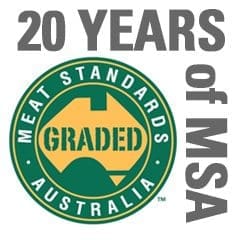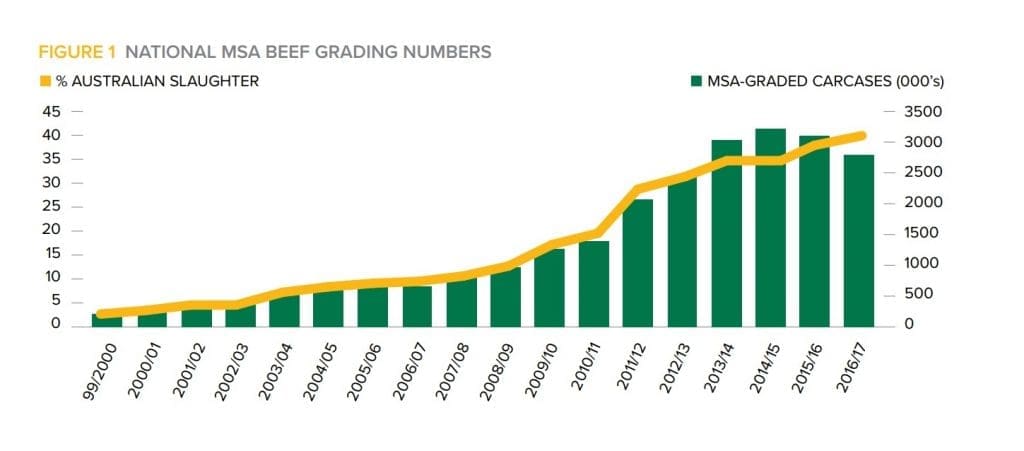THE red meat industry paused to celebrate and reflect on one of its outstanding success stories this morning, when the Meat Standards Australia program officially notched-up 20 years of commercial operations.
After 12 months under a pilot trial in the southeast Queensland and WA markets, the MSA program took its first tentative fully-commercial steps during the early stages of 1998.
 A breakfast gathering in Brisbane this morning hosted by Meat & Livestock Australia marked the milestone, and included a large group of stakeholders and supporters – some of whom had been part of the program since its inception.
A breakfast gathering in Brisbane this morning hosted by Meat & Livestock Australia marked the milestone, and included a large group of stakeholders and supporters – some of whom had been part of the program since its inception.
“Looking back to the mid-1990s and what was happening in the beef industry at the time, it took tremendous industry vision to take the initiative to start to invest in the research that led to MSA, and begin to really understand our consumers,” MLA’s general manager for producer consultation and adoption Michael Crowley told this morning’s gathering.
“Back then, 38 percent of consumers said they were finding it difficult to buy beef that met their expectations of quality. Fifty seven percent had difficulty predicting tenderness by looking at the raw product; 80 percent said price was no indicator of quality; and 90 percent thought fat equalled poor quality.”
“There was so much confusion and uncertainty in the marketplace that consumers were limiting beef purchasing, because of it,” Mr Crowley said.
Early research funded by industry groups (see this morning’s separate story) said the industry needed to know more about the consumer. In one trial, 50pc of striploins purchased out of a Queensland supermarket program, failed to meet ‘good everyday’ eating quality standard when consumers tested it.
“Back in the early days, there were some real pioneers – and that list included scientists, commercial early-adopters, graders and the leaders of the industry at the time – some of who are present at this morning’s gathering,” Mr Crowley said.
“Thinking about the program’s early days, and some of the difficult challenges it faced (more on that in a separate article in this series), it’s quite incredible how the program has evolved to where it is today.”
Grading numbers continue to surge
In the program’s first full year, driven mostly by a small group of stakeholders with vision, foresight and preparedness to take some risk, about 200,000 head of cattle were MSA graded across Australia.
As the graph plotting annual grading numbers published here shows, MSA has continued to grow and evolve, on the back of robust science, always focused on consumer outcomes.
One million cattle were graded in a single year for the first time in 2009/10, continuing to rise year-on year to 2014-15, when more than three million head were graded. Only herd decline caused by drought has stopped that sequence of continuous growth, with 2.7 million head graded last financial year.
In percentage terms, MSA grading now accounts for a record 42pc of the Australian adult cattle slaughter.
Despite lofty early expectations, MSA was certainly no overnight success at the commercial level. There was uptake among some progressive butchers and food service operators, and innovative and forward-thinking mid-sized processors. But pProgress in terms of throughput was slow in the early years after implementation, partly because major retail supermarket groups and larger corporate processors showed no interest in formally adopting the MSA standard.
At retail, MSA became a tool used only by some independent butchers, and a handful of smaller independent supermarket groups.
In the case of both major supermarket groups, Coles and Woolworths, they quickly adopted most, if not all of the MSA meat science, but would not identify the retail product in chilled cabinets as backed by MSA, for commercial reasons. Their explanation at the time was that they were focussed on developing their own internal brand identifiers for their beef offer, and an inclusion of an MSA label would only serve to dilute and confuse their own brand identities.
Secondly, if one major supermarket group adopted MSA, there would be nothing to stop the other from doing the same. If identical MSA labels appeared on beef in both chains, customer loyalty would be compromised by eroding any point of difference, they argued.
This deadlock remained in place for 13 years, until a change of strategic direction within the Woolworths management camp saw a milestone achieved in January, 2012, when the nation’s largest supermarket group formally adopted MSA in its 850 retail stores.
That decision is clearly reflected in the graph published above.
Similarly, none of the nation’s largest beef processors saw value in adopting MSA during its first seven or eight years. The reasons were many, and varied: most of the large processors at that time were heavily export focussed, with domestic supply very much a derivative of their main business; others struggled to see how they would make money out of adopting an MSA supply program. The need for greater segmentation in the chillers was another point of resistance.
Progressively, as both retail and food service sector demand for MSA beef gained momentum, the dyke started to break. Another significant catalyst for change was a shift to company-based MSA grading in 2005.
The nation’s second largest processor, Teys Brothers, had carried out some MSA trails as early as 2002, but established its first commercial uptake of MSA from early 2008. Within 12 months of that, however, programs were in place at the company’s Naracoorte, Beenleigh, Biloela and Lakes Creek abattoirs. Swift Australia (later to become JBS Australia) followed a similar path, and by late 2009, nine of the nation’s ten largest processors ran MSA programs.
Move to cuts based system
Over time, MSA has moved from a carcase-based to cuts-based system, and is now able to account for all breed types, production systems, inputs, interventions – and cook-methods – all tested using consumer sensory taste panel work around the world. More than 800,000 consumers in 11 countries have now sampled product under sensory testing work.
MLA managing director Richard Norton told this morning’s audience that some 50,000 producers across Australia were now participating in the MSA program; 156 commercial red meat brands across Australia were underpinned by MSA; and last year, after 20 years, beef exports sold on an eating quality cipher had commenced.
“That to me is incredible,” he said. “To think that an eating quality cipher has changed the myths and the old grading systems that limited the way we have transacted beef over the past century is a breakthrough.” See Beef Central original report on last year’s adoption of an EQA cipher here.
“What we as an industry should learn out of MSA is the foresight and vision needed to push through to deliver programs that are going to benefit the red meat industry in the long-term,” Mr Norton said. “I only hope that we have visionaries in our industry today like those that delivered MSA.”
He said total expenditure on MSA since inception had been $153 million, of which $48 million had come from the Federal Government. “We must recognise the important contributions of our federal governments, through the RDC portfolio,” he said.
“It’s a partnership that delivered a return during 2010 and 2015 that was independently assessed of $12 earned for every $1 spent on the program. That’s an incredible investment.”
MSA program manager Sarah Strachan said compliance to MSA minimum beef requirements had continued to improve last year. Across the country compliance in 2016-17 reached 93.9pc, with the average MSA Index also increasing to 57.59 points.
MSA producers can now benchmark the performance of their cattle against other producers using the myMSA feedback system. The new myMSA Benchmarking tool provides producers with the opportunity to benchmark their cattle’s compliance and MSA Index results against other producers in their region, state or across the country. Parameters can be refined by selecting for feed type, HGP status and time-frame, providing more meaningful feedback about producers’ own enterprises and performance.
Beef producers have continued to embrace carcase feedback with one-third of producers consigning MSA cattle during the year accessing the myMSA feedback system.
More resources to support producers to continue to strive for excellence were released throughout 2016–17, with Benchmarking now available within myMSA. This allows producers to compare themselves for compliance and eating quality performance against other producers in their region, state or the country. This new resource offers more meaningful feedback to assist on-farm decisions.
Throughout the 2016-17 year, significant eating-quality research projects were launched to ensure that the year 2020 goals of the MSA program are achieved.
That includes all cattle in Australia being eligible for MSA grading, and their eating quality being accurately predicted. The MSA program has its sights set on accounting for more than 50pc of the cattle slaughter being MSA graded by the year 2020.
Last year, the MSA program received an update by removing meat colour as a minimum requirement based on research using our world-leading consumer sensory testing protocols that confirmed meat colour does not have an impact on eating quality. See Beef Central’s earlier coverage of that development here.
- See this morning’s separate MSA 20 years story – “Genesis of a world-class beef grading system”
- Beef Central will publish a series of further articles in coming weeks marking MSA’s 20th anniversary. Next: The importance of the ‘Empty Chair’


